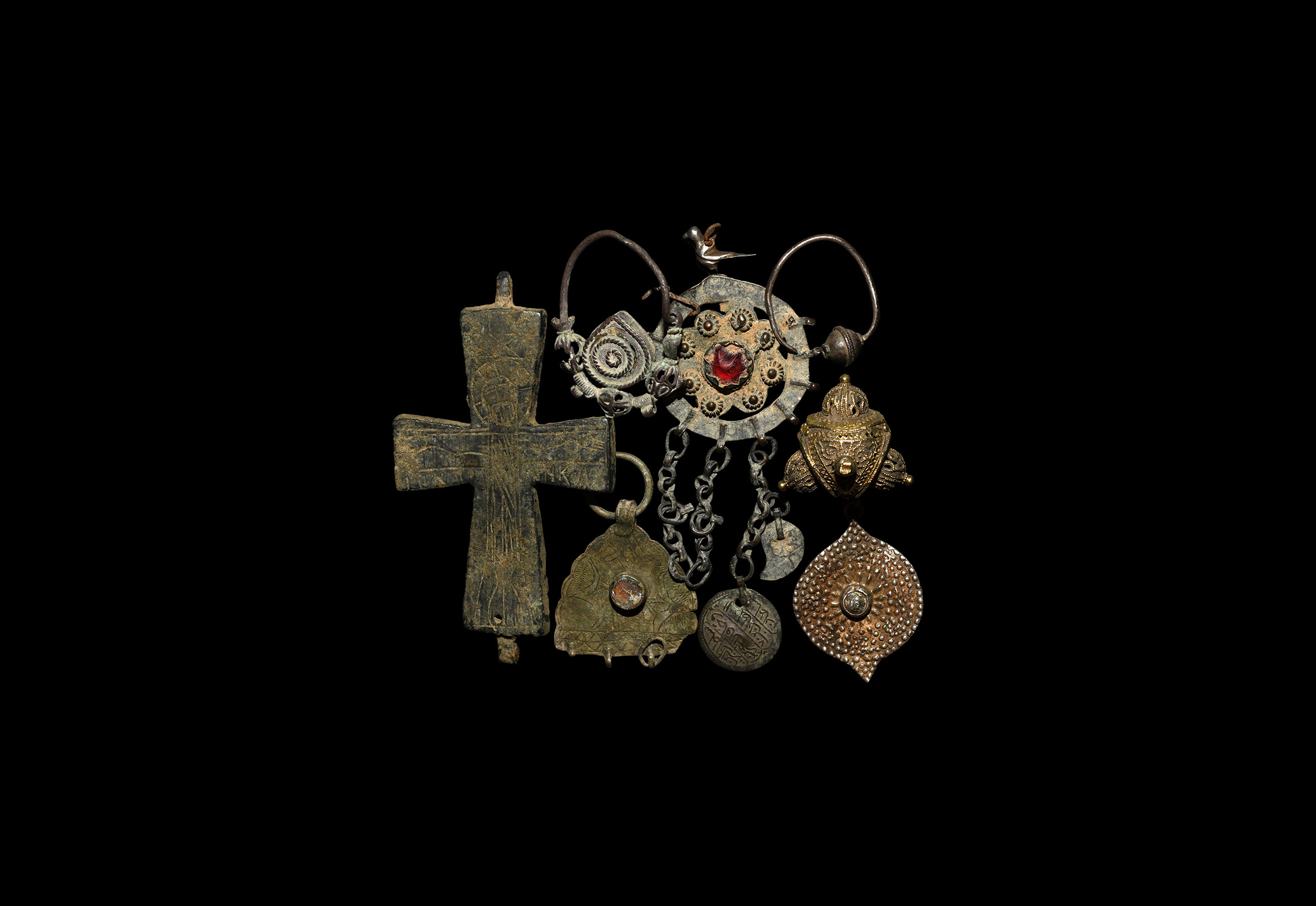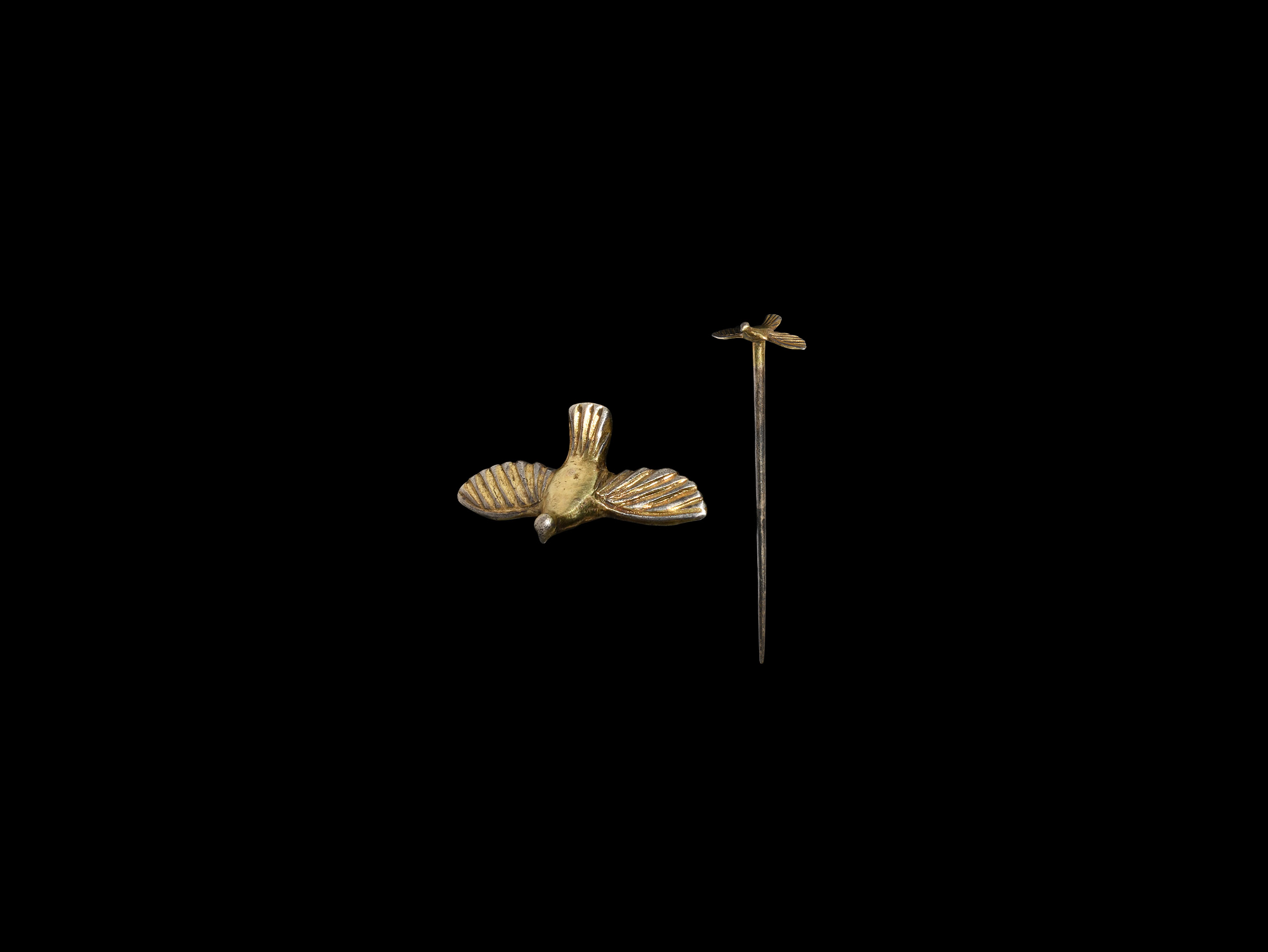Roman Signum Finial or Votive Hand to the God Sabazios 2nd-3rd century AD A life-sized bronze hand with open palm, the fingers raised as a stop sign with well-marked detailing, socketted at wrist to accept the staff insert, the socket rim formed as a coiled snake with its head resting at the centre of the wrist, a Gnostic symbol above; the palm with Greek inscription 'ΙΟΥΛΙΟϹ [Α]ΛΛΑΞΙMΟϹ ΚΑTΕΥKHN ΑΝΕΘΗΚΕΝ' for 'dedicated by Ioulios Allaximos as a prayer' or 'dedicated by Ioulios Allaximos as one would wish'; most likely a standard finial or a votive; mounted on a custom-made stand. 1.7 kg total, 28cm including stand (11"). Fine condition. Provenance Property of a London gentleman; acquired on the London art market in the 2000s; accompanied by an academic report by Dr. Raffaele D’Amato. Literature See for a similar item from Martigny, in Zürich, Schweizerisches Landesmuseum, inventory no. 41434; see Von Gonzenbach, V., Fides Exercituum, eine Hand von Vindonissa, in Jahrbuch der Gesellschaft Pro Vindonissa, 1951-1952, pp.5ff.; D’Amato, R., Arms and armour of the Roman Imperial Soldier, 112 BC - AD 192, London, 2009, p. 170, fig.239; Toepfer K.M., Die römischen Feldzeichen in der Republik und im Prinzipat, Mainz, 2011, NZ52; D’Amato, R., Roman standards and standard-bearers, (1), 112 BC - AD 192, Oxford, 2018, p.31. Footnotes Roman military signa decorated by a phalera and surmounted by a right hand have been used since the Late Consular Age, as can be seen on the Scafa reliefs (Toepfer, 2011, WF10, pl. 125, pp. 396 ff.) and in the Church of San Domenico in Sora (D'Amato, 2009, p.127), where the presence of the hand suggests the representation of Signa Manipulorum (Standards of the Maniples). The hand (manus) symbolised the fides, ie. the allegiance between the soldiers and the Res Publica. During the Imperial Age, the identification element of the signum manipularis was possibly a hand, a small shield, or another symbol on the top of the standard.
Roman Signum Finial or Votive Hand to the God Sabazios 2nd-3rd century AD A life-sized bronze hand with open palm, the fingers raised as a stop sign with well-marked detailing, socketted at wrist to accept the staff insert, the socket rim formed as a coiled snake with its head resting at the centre of the wrist, a Gnostic symbol above; the palm with Greek inscription 'ΙΟΥΛΙΟϹ [Α]ΛΛΑΞΙMΟϹ ΚΑTΕΥKHN ΑΝΕΘΗΚΕΝ' for 'dedicated by Ioulios Allaximos as a prayer' or 'dedicated by Ioulios Allaximos as one would wish'; most likely a standard finial or a votive; mounted on a custom-made stand. 1.7 kg total, 28cm including stand (11"). Fine condition. Provenance Property of a London gentleman; acquired on the London art market in the 2000s; accompanied by an academic report by Dr. Raffaele D’Amato. Literature See for a similar item from Martigny, in Zürich, Schweizerisches Landesmuseum, inventory no. 41434; see Von Gonzenbach, V., Fides Exercituum, eine Hand von Vindonissa, in Jahrbuch der Gesellschaft Pro Vindonissa, 1951-1952, pp.5ff.; D’Amato, R., Arms and armour of the Roman Imperial Soldier, 112 BC - AD 192, London, 2009, p. 170, fig.239; Toepfer K.M., Die römischen Feldzeichen in der Republik und im Prinzipat, Mainz, 2011, NZ52; D’Amato, R., Roman standards and standard-bearers, (1), 112 BC - AD 192, Oxford, 2018, p.31. Footnotes Roman military signa decorated by a phalera and surmounted by a right hand have been used since the Late Consular Age, as can be seen on the Scafa reliefs (Toepfer, 2011, WF10, pl. 125, pp. 396 ff.) and in the Church of San Domenico in Sora (D'Amato, 2009, p.127), where the presence of the hand suggests the representation of Signa Manipulorum (Standards of the Maniples). The hand (manus) symbolised the fides, ie. the allegiance between the soldiers and the Res Publica. During the Imperial Age, the identification element of the signum manipularis was possibly a hand, a small shield, or another symbol on the top of the standard.















Try LotSearch and its premium features for 7 days - without any costs!
Be notified automatically about new items in upcoming auctions.
Create an alert